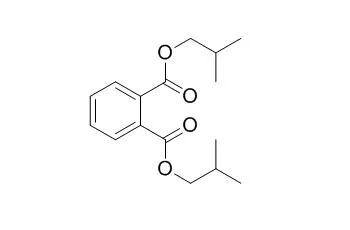| Description: |
Diisobutyl phthalate has comparable anti-androgenic effects to di-n-butyl phthalate in fetal rat testis. Diisobutyl phthalate administered by gavage is embryotoxic and teratogenic, and affects the developing male reproductive tract, at maternal toxic doses. Diisobutyl phthalate could through blood-brain barrier after oral intake, and disordered the way of apoptosis of hippocampal cells, and morphologic change of mitochondria mybe is the main reason of changes of neuron apoptosis; it induced oxidative stress, which can decrease the activities of antioxidative enzymes and result in oxidative damage of tissues. |
| In vivo: |
| Toxicol Lett. 2006 Jun 1;163(3):183-90. | | Diisobutyl phthalate has comparable anti-androgenic effects to di-n-butyl phthalate in fetal rat testis.[Pubmed: 16458459] | Phthalates are widely used as plasticizers in various consumer products and building materials. Some of the phthalates are known to interfere with male reproductive development in rats, and di-n-butyl phthalate (DBP), diethylhexyl phthalate (DEHP) and butyl benzyl phthalate (BBP) were recently banned for use in toys in the EU mainly due to their reproductive toxicity. Diisobutyl phthalate (DiBP) has similar structural and application properties as DBP, and is being used as a substitute for DBP. However, knowledge on male reproductive effects of DiBP in experimental animals is lacking.
METHODS AND RESULTS:
In the current study, four groups of pregnant Wistar rats were exposed to either 0mg/kg bw/day or 600 mg/kg bw/day of DiBP from gestation day (GD) 7 to either GD 19 or GD 20/21. Male offspring was examined at GD 19 or GD 20/21 for effects on testicular testosterone production and testicular histopathology. Changes in anogenital distance (AGD) were evaluated as an indication of feminisation of males.
Anogenital distance was statistically significantly reduced at GD 20/21 together with reductions in testicular testosterone production and testicular testosterone content. Histopathological effects (Leydig cell hyperplasia, Sertoli cell vacuolisation, central location of gonocytes and presence of multinuclear gonocytes) known for DBP and DEHP were observed in testes of DiBP-exposed animals at GD 20/21. Additionally, immunohistochemical expression of P450scc and StAR proteins in Leydig cells was reduced by DiBP. At GD 19, these effects on anogenital distance, testosterone levels and histopathology were less prominent.
CONCLUSIONS:
In this study, GD 20/21 rather than GD 19 appears to be the optimal time for investigating changes in anogenital distance, testosterone levels, and testicular histopathology. DiBP has similar testicular and developmental effects as DBP and DEHP, and although more developmental and especially postnatal studies are needed to clearly identify the reproductive effects of DiBP, this study indicates a reason for concern about the use of DiBP as a substitute for DBP. | | Wei Sheng Yan Jiu. 2013 Jan;42(1):57-60. | | Effect of diisobutyl phthalate on learning and memory behavior and apoptosis of hippocampus cells in mice.[Pubmed: 23596708] |
To give the original research of Diisobutyl phthalate (DiBP) on learning and memory behavior, determine whether it can through blood-brain barrier and effect apoptosis of hippocampus cells in mice.
METHODS AND RESULTS:
Accommodating 60 Kunming mice to the animal house for 3 days, then dividing the mice into 5 groups according to their weights. That is, one control group and four experimental groups (I group, 50 mg/kg BW. II group, 250mg/kg BW. III group, 500 mg/kg BW. IV group, 1000 mg/kg BW). The mice were fed with the corn oil in control group, and the other groups were fed with the related dose of Diisobutyl phthalate mixture by gavages last for 8 weeks. At the end of experimental time, passive avoidance response was examined, then all of mice were killed, and choosed the brain tissues to test the DiBP content and apoptosis rate of hippocampal cells and hippocampal ultrastructural alterations on electron microscopy.
In the passive avoidance response test, the exposed animals of IV group showed learning impairment as compared to unexposed mice (P < 0.05). DiBP was detected in III group and IV group, the mean content of them were (1.27 +/- 0.56) and (1.96 +/- 0.42) microg/g. The apoptosis rate of hippocampal cells (IV group vs control group) increase significantly (P < 0.05). Hippocampal ultrastructural were damaged in all dose-groups.
CONCLUSIONS:
As a result, in the experiments, exposure to DiBP could exert passive avoidance neurobehavioral effects. DiBP could through blood-brain barrier after oral intake, and disordered the way of apoptosis of hippocampal cells, and morphologic change of mitochondria mybe is the main reason of changes of neuron apoptosis. |
|






 Cell. 2018 Jan 11;172(1-2):249-261.e12. doi: 10.1016/j.cell.2017.12.019.IF=36.216(2019)
Cell. 2018 Jan 11;172(1-2):249-261.e12. doi: 10.1016/j.cell.2017.12.019.IF=36.216(2019) Cell Metab. 2020 Mar 3;31(3):534-548.e5. doi: 10.1016/j.cmet.2020.01.002.IF=22.415(2019)
Cell Metab. 2020 Mar 3;31(3):534-548.e5. doi: 10.1016/j.cmet.2020.01.002.IF=22.415(2019) Mol Cell. 2017 Nov 16;68(4):673-685.e6. doi: 10.1016/j.molcel.2017.10.022.IF=14.548(2019)
Mol Cell. 2017 Nov 16;68(4):673-685.e6. doi: 10.1016/j.molcel.2017.10.022.IF=14.548(2019)